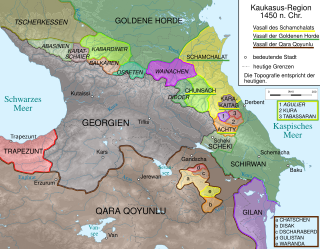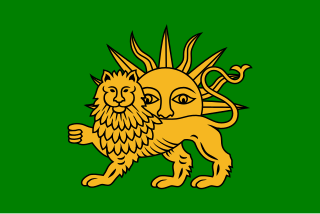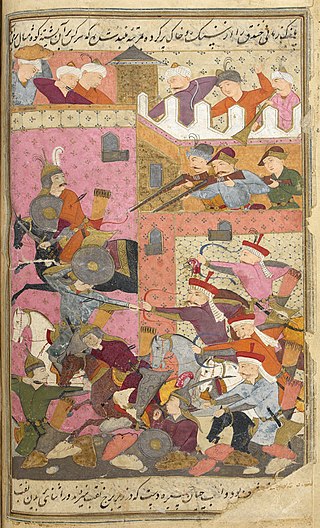
Tahmasp I was the second shah of Safavid Iran from 1524 until his death in 1576. He was the eldest son of Ismail I and his principal consort, Tajlu Khanum. Ascending the throne after the death of his father on 23 May 1524, the first years of Tahmasp's reign were marked by civil wars between the Qizilbash leaders until 1532, when he asserted his authority and began an absolute monarchy. He soon faced a long-lasting war with the Ottoman Empire, which was divided into three phases. The Ottoman sultan, Suleiman the Magnificent, tried to install his own candidates on the Safavid throne. The war ended with the Peace of Amasya in 1555, with the Ottomans gaining sovereignty over Iraq, much of Kurdistan, and western Georgia. Tahmasp also had conflicts with the Uzbeks of Bukhara over Khorasan, with them repeatedly raiding Herat. In 1528, at the age of fourteen, he defeated the Uzbeks in the Battle of Jam by using artillery, unknown to the other side.

Ismail I, also known as Shah Ismail, was the founder of the Safavid dynasty of Iran, ruling as its King of Kings (Shahanshah) from 1501 to 1524. His reign is often considered the beginning of modern Iranian history, as well as one of the gunpowder empires.

The Qara Qoyunlu or Kara Koyunlu, also known as the Black Sheep Turkomans, were a culturally Persianate, Muslim Turkoman monarchy that ruled over the territory comprising present-day Azerbaijan, Georgia, Armenia, northwestern Iran, eastern Turkey, and northeastern Iraq from about 1374 to 1468.
Uzun Hasan or Uzun Hassan was a ruler of the Turkoman Aq Qoyunlu state and is generally considered to be its strongest ruler. Hasan ruled between 1452 and 1478, and would preside over the confederation's territorial apex when it included parts or all of present-day Iraq, Turkey, Azerbaijan, Iran, Transcaucasia and Syria.

Farrukh Yasar was the last independent Shirvanshah of Shirvan (1465–1500). In 1500, the first Safavid ruler, Ismail I, decisively defeated and killed Farrukh Yasar during his conquest of the area. Descendants of Farrukh Yasar continued to rule Shirvan under Safavid suzerainty, until 1538, when Ismail's son and successor Tahmasp I appointed its first Safavid governor, and made it a fully functioning Safavid province.

The Aq Qoyunlu or the White Sheep Turkomans was a culturally Persianate, Sunni Turkoman tribal confederation. Founded in the Diyarbakir region by Qara Yuluk Uthman Beg, they ruled parts of present-day eastern Turkey from 1378 to 1503, and in their last decades also ruled Armenia, Azerbaijan, much of Iran, Iraq, and Oman where the ruler of Hormuz recognised Aq Qoyunlu suzerainty. The Aq Qoyunlu empire reached its zenith under Uzun Hasan.

Jalal al-Din Davani, also known as Allama Davani, was a theologian, philosopher, jurist, and poet, who is considered to have been one of the leading scholars in late 15th-century Iran.

After the devastating invasions by Timur and subsequent enfeeblement of the Kingdom of Georgia, it soon faced a new threat. Timur's death in 1405 marked the beginning of the end of his Empire, unified only by fear and blood of the subjected peoples. Turkomans, particularly the Kara Koyunlu clan, were among the first to rebel against Shah Rukh who ruled most of the Persia and Mawerannahr. Qara Yusuf, ruler of the Kara Koyunlu, defeated Shah Rukh, captured Baghdad, and repulsed Timurids from western Persia. After they established themselves as the new leading power in the middle east. They took advantage of the temporary weakness of the Georgians and launched attacks against them as early as 1407 during which Qara Yusuf took 15,000 prisoners and killed George VII of Georgia. Constantine I of Georgia, fearing further encroachment, allied himself with the Shirvanshah Ibrahim I to counter Turkoman advance and engaged them in the Battle of Chalagan, in which he was defeated and taken captive. In captivity Constantine behaved very proudly, which infuriated Qara Yusuf to such an extent, that he ordered his, his half-brother David's and 300 Georgian nobles' execution.

Safavid Iran or Safavid Persia, also referred to as the Safavid Empire, was one of the greatest Iranian empires after the 7th-century Muslim conquest of Persia, which was ruled from 1501 to 1736 by the Safavid dynasty. It is often considered the beginning of modern Iranian history, as well as one of the gunpowder empires. The Safavid Shāh Ismā'īl I established the Twelver denomination of Shīʿa Islam as the official religion of the empire, marking one of the most important turning points in the history of Islam.
Hossein Beg Laleh Shamlu was a Qizilbash officer of Turkoman origin, who occupied high offices under the Safavid king Ismail I and was the first person to serve as the vakil (vicegerent) of the empire.
The Kujuji family was an Iranian noble-family native to Tabriz in Iran, and was present from the 15th century to the 18th-century. The first known mentioned member of the family is Amir Zakariya, an officer who originally served as vizier of the Aq Qoyunlu federation, but later changed his allegiance to the Safavid king (shah) Ismail I, and was appointed as his vizier by him, thus becoming the first vizier of the Safavid Empire. Zakariya later died in 1512/3.

The conquest of Shirvan was the first campaign of Ismail, the leader of the Safavid order. In late 1500, Ismail marched into Shirvan, and, despite heavily outnumbered, decisively defeated the then incumbent Shirvanshah Farrukh Yassar in a pitched battle, in which the latter and his entire army were killed. The conquest resulted in the toppling of the Shirvanshahs as autonomous rulers, who had ruled large parts of the Caucasus for centuries, and the incorporation of their domain.
Tajlu Khanum or Tajli Begum, also known by her title of Shah-Begi Khanum, was a Turkoman princess from the Mawsillu tribe and mother of Tahmasp I.
Qazi Isa Savaji was a Persian bureaucrat from the Savaji family, who was among the leading figures during the reign of the Aq Qoyunlu rulers Uzun Hasan and Ya'qub Beg.
Sharaf al-Din Shah-Mahmud Jan Daylami Qazvini, better known as Mahmud Jan Daylami was an Iranian bureaucrat from the Daylami family, who occupied high offices under the Aq Qoyunlu and the Safavids.
Sufi Khalil Beg Mawsilu was a Turkoman military officer from the Mawsillu clan, who served the Aq Qoyunlu. He was one of the leading figures during the reign of Sultan Ya'qub Beg, and played a pivotal role in the succession struggle that took place after the latter's death. He put Ya'qub's eldest son Baysunghur on the throne, ruling as the virtual ruler of the realm until he was defeated and killed by his rival, Sulayman Beg Bijan.
The Battle of Sharur occurred in July 1501. It ended with a decisive victory for the Safavid army. After this victory, the way of the Safavids to Tabriz was opened. Alvand Mirza disappeared from the political scene.

Alvand Mirza was a Aq Qoyunlu prince, who was a contender for the throne between 1497 and 1504/5.

Sultan Murad was the last sultan of the Aq Qoyunlu from 1497 to 1508. After losing his kingdom to the Safavid Shah Ismail I, he fled to Diyar Bakr, where he was eventually killed by Shah Ismail's Qizilbash soldiers at the end of 1514.











